The Taiwanese military is on high alert and is closely monitoring the Chinese People’s Liberation Army’s (PLA) air and naval deployments after Beijing yesterday reserved seven airspace areas east of its Zhejiang and Fujian provinces through Wednesday.
Beijing’s action was perceived as a precursor to a potential third “Joint Sword” military exercise, which national security experts said the PLA could launch following President William Lai’s (賴清德) state visits to the nation’s three Pacific allies and stopovers in Hawaii and Guam last week.
Unlike the Joint Sword military exercises in May and October, when Beijing provided detailed information about the affected areas, it has yet to formally announce any planned military drills.
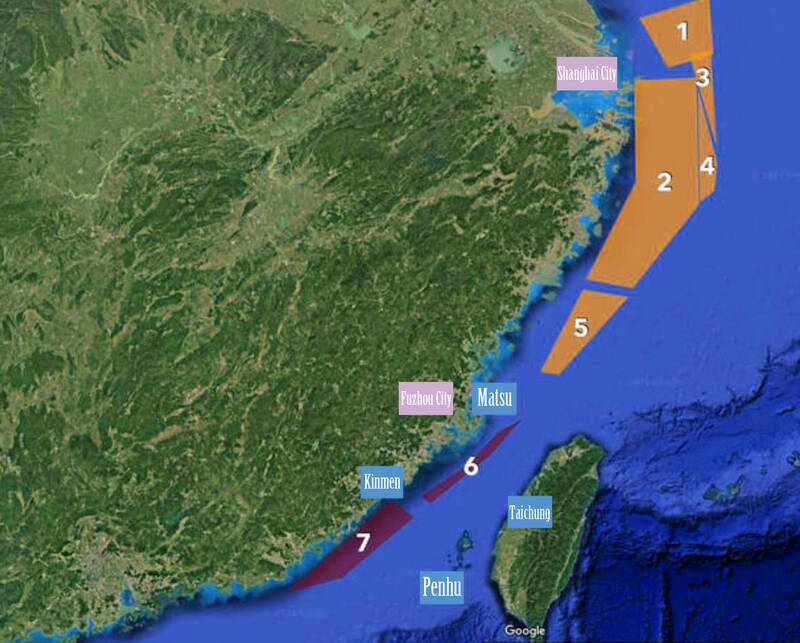
Illustration: Taipei Times
The Chinese Ministry of Foreign Affairs declined to answer when asked about launching military drills in response to Lai’s overseas trip, with spokeswoman Mao Ning (毛寧) simply reiterating the importance of Chinese sovereignty and maintaining Chinese territorial integrity.
While the previous two exercises focused on drills by the PLA’s Eastern Theater Command, Taiwan’s Ministry of National Defense said its intelligence had identified naval formations not only in the Eastern Theater Command, but also in the Northern and Southern Theater Commands.
The ministry added that it had detected China Coast Guard vessels entering areas around the Taiwan Strait and Western Pacific.
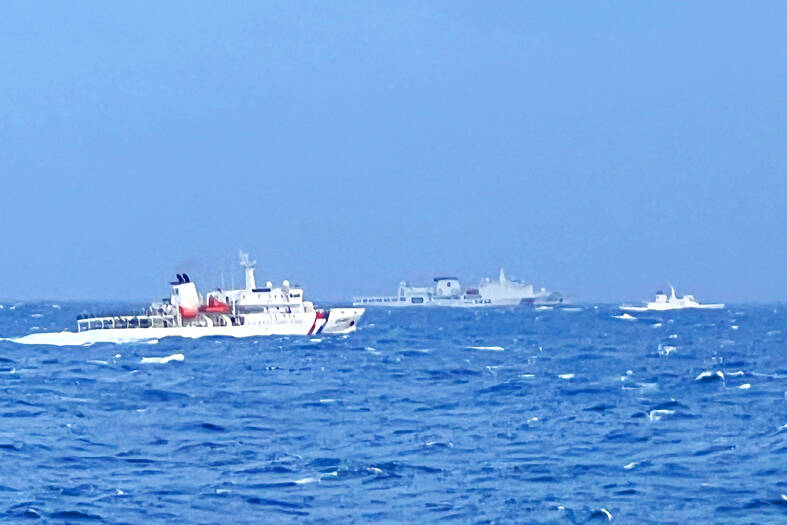
Photo: AFP / CGA
The Chinese aircraft carrier Liaoning joined the second Joint Sword military exercise in October. Whether the carrier would join a third one remains to be seen.
Another difference about the anticipated drills is the area covered by the seven reserved airspace zones, which range from Shanghai in the north and Shantou in the south, with two of the zones close to Kinmen and Lienchiang (Matsu) counties.
The defense ministry said that it has initiated combat-readiness drills at strategic locations nationwide and was working closely with the Coast Guard Administration (CGA) on appropriate countermeasures.
The CGA said it has detected “unusual activities” by several Chinese coast guard vessels in waters around Taiwan since Friday, including three last week and four yesterday.
Last week, the China Coast Guard ship No. 2901 navigated through waters south of the Taiwan Strait, while No. 1301 and No. 1302 ships navigated southward via waters off Taiwan’s northeast coast, the CGA said.
All three eventually gathered at about 50 to 60 nautical miles (93 km to 111km) off the northeast coast of Green Island on Taiwan’s east coast.
Yesterday, China Coast Guard vessels 2203, 2302, 2304 and 2307 navigated toward waters off Taiwan’s southwest coast, the CGA said.
None of them entered Taiwan’s restricted waters, it added.
Using a one-on-one approach, the CGA also dispatched seven ships to closely monitor the whereabouts of the China Coast Guard ships, it said.

People can preregister to receive their NT$10,000 (US$325) cash distributed from the central government on Nov. 5 after President William Lai (賴清德) yesterday signed the Special Budget for Strengthening Economic, Social and National Security Resilience, the Executive Yuan told a news conference last night. The special budget, passed by the Legislative Yuan on Friday last week with a cash handout budget of NT$236 billion, was officially submitted to the Executive Yuan and the Presidential Office yesterday afternoon. People can register through the official Web site at https://10000.gov.tw to have the funds deposited into their bank accounts, withdraw the funds at automated teller
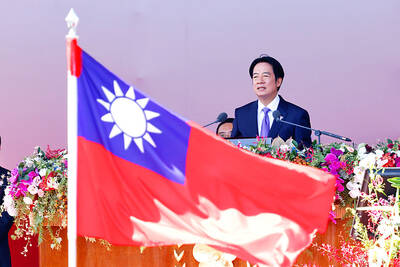
PEACE AND STABILITY: Maintaining the cross-strait ‘status quo’ has long been the government’s position, the Ministry of Foreign Affairs said Taiwan is committed to maintaining the cross-strait “status quo” and seeks no escalation of tensions, the Ministry of Foreign Affairs (MOFA) said yesterday, rebutting a Time magazine opinion piece that described President William Lai (賴清德) as a “reckless leader.” The article, titled “The US Must Beware of Taiwan’s Reckless Leader,” was written by Lyle Goldstein, director of the Asia Program at the Washington-based Defense Priorities think tank. Goldstein wrote that Taiwan is “the world’s most dangerous flashpoint” amid ongoing conflicts in the Middle East and Russia’s invasion of Ukraine. He said that the situation in the Taiwan Strait has become less stable
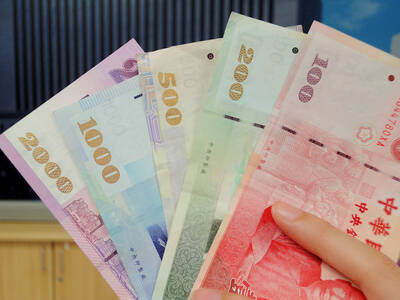
FRESH LOOK: A committee would gather expert and public input on the themes and visual motifs that would appear on the notes, the central bank governor said The central bank has launched a comprehensive redesign of New Taiwan dollar banknotes to enhance anti-counterfeiting measures, improve accessibility and align the bills with global sustainability standards, Governor Yang Chin-long (楊金龍) told a meeting of the legislature’s Finance Committee yesterday. The overhaul would affect all five denominations — NT$100, NT$200, NT$500, NT$1,000 and NT$2,000 notes — but not coins, Yang said. It would be the first major update to the banknotes in 24 years, as the current series, introduced in 2001, has remained in circulation amid rapid advances in printing technology and security standards. “Updating the notes is essential to safeguard the integrity
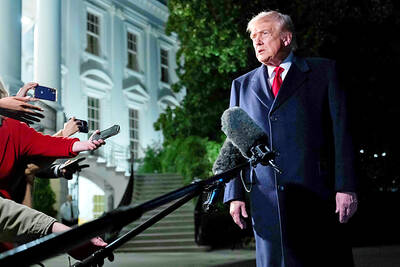
REASSURANCE: The US said Taiwan’s interests would not be harmed during the talk and that it remains steadfast in its support for the nation, the foreign minister said US President Donald Trump on Friday said he would bring up Taiwan with Chinese President Xi Jinping (習近平) during a meeting on the sidelines of the APEC Summit in South Korea this week. “I will be talking about Taiwan [with Xi],” Trump told reporters before he departed for his trip to Asia, adding that he had “a lot of respect for Taiwan.” “We have a lot to talk about with President Xi, and he has a lot to talk about with us. I think we’ll have a good meeting,” Trump said. Taiwan has long been a contentious issue between the US and China.